adverts
Isaac Qwesi Bondzie, Chief Executive Officer (CEO) of the Prime Harmony Foundation, has advised parents not to use their children for menial employment because it is illegal.
As part of the global celebration of the United Nations’ (UN) “World Day Against Child Labour” on Wednesday, June 12, 2024, he made the appeal in an interview with Puretvonline.com.
The UN states that the theme of this year’s World Day will be commemorating the Worst Forms of Child Labour Convention’s 25th anniversary of adoption (1999, No. 182). Additionally, it’s a chance to urge all parties involved in preventing child labour to better execute Convention No. 182 and Convention No. 138, which deal with the Minimum Age for Admission to Employment or Work (1973) and Convention No. 182, respectively.
adverts
While there has been progress in decreasing child labour over the years, current global trends have reversed, highlighting the urgent need to coordinate efforts in accelerating efforts to end child labour in all of its forms.
The international community pledged to end child work in all its forms by 2025 when it adopted Sustainable Development Goal Target 8.7.
Speaking on the theme, Mr. Isaac Qwesi Bondzie stated that 21.8% of kids between the ages of five and seventeen worked as slaves. Compared to females (20.8%), a somewhat greater percentage of male youngsters (22.7%) were involved in child labour. Children in urban areas made up 12.4% of the child labour force, while children in rural regions made up 30.2% of the workforce. With regard to children working, rural Savannah had the largest percentage (34.6%). Twelve to fourteen-year-olds had the highest likelihood of working as minors (26.7%) of all the age groups.

A little over fourteen percent (14.2%) of the children surveyed were working as minors in dangerous jobs. Males were slightly more likely than females (12.9%) to be involved in dangerous forms of child employment (15.4%). The percentage of children in hazardous kinds of child employment varied significantly between urban areas (7.7%) and rural areas (20.0%).
76.4 percent of children aged 5 to 17 who engaged in economic activity were engaged in child labour, with 49.7 percent of them doing dangerous jobs. Over seven Of the children who engaged in economic activity, ten were male and ten were female, and over forty percent were involved in dangerous kinds of child labour.
Of the children who worked on home tasks, slightly more than one-quarter (25.3%) were involved in child labour, and 16.6% worked in dangerous jobs. Males were more likely than females to perform household duties, engage in child employment, and engage in hazardous kinds of child labour (26.7% and 18.5%, respectively). (Child labour in hazardous forms: 14.8% and child labour in 23.9%).
Rural savannah had the largest percentage of children working as minors who did not experience any harm to their health (17.7%), followed by rural forest (17.0%). With 10.7 percent, rural-coastal areas had the lowest percentage.
Even though the government is succeeding in the education sector, particularly with the Free SHS policy, Isaac Qwesi Bondzie continued, he thought that in order to lower child labour, the government and stakeholders should also educate parents in rural areas and even in some impoverished communities within the city of Accra.
He urged the government to enact laws and policies that would make it easier to combat this threat.
In an effort to support teachers and encourage students to learn, he mentioned that his company had been able to provide school uniforms and other educational materials to a few schools in rural villages.
Then, in an effort to gradually end child labour, he urged stakeholders to assist low-income parents or kids in the community.


